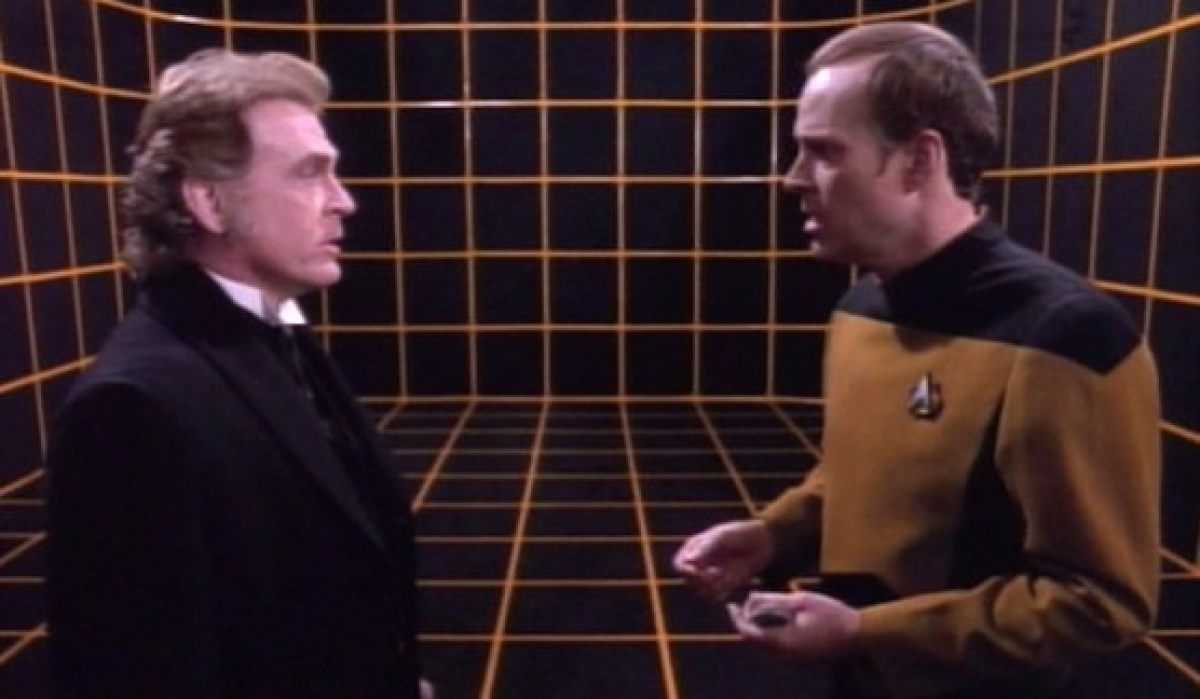Eyes-On With The Oculus Rift And Our Virtual Reality Addicted Future
When I introduced myself at the start of the year, I pointed to the Oculus Rift as one of my most anticipated gaming-related things of 2014. Fifty thousand prototypes were in circulation (they've sold so many, they've had to stop selling them due to parts shortages), yet I had not managed to get my face into one. It was my virtual reality white whale. My gaming Bigfoot.
Well, consider that whale harpooned and that Bigfoot blurrily photographed, because a programmer friend of mine has since lent me his Rift development kit into which to dive, my giddiness concealed beneath a convenient cloak of internet journalism.
The Oculus Rift is one of Kickstarter’s great success stories, a virtual reality headset that raised $2.4 million in crowdfunding and a further $90 million in capital investments. It’s easy to see why investors are getting behind Oculus. Virtual reality has been a dream for engineers and consumers alike for decades. John Carmack, Doom and Quake creator and now Oculus CTO, once described its creation - using Neal Stephenson’s Snow Crash as a model - as a “moral imperative”. Up until now though, most VR products, like Nintendo’s Virtual Boy, died a fiery death at retail, thanks predominantly to being kinda shitty. They had a narrow field of view, poor graphics, laggy head tracking, or all of the above. Anyone who frequented video arcades in the 90s or saw Sinbad’s heartwarming comedy classic First Kid knows just how clunky VR tech used to be.
Oculus, however, seized an opportunity afforded them by modern cellphone tech, plugging the displays and accelerometers that make your iPhones so fancy into a headset that, hopefully, will see a final release by 2015. It’s a genius bit of repurposing, aided by excellent software design and engineering.
NB: The model I tested is the original development kit. Since then, a new prototype (dubbed Crystal Cove) has introduced a higher resolution screen, low-persistence displays, and positional head tracking to account for spatial as well as directional movement.

The author, fighting off digital enemies and real nausea.
For such a revolutionary and unpolished device, setup of the Rift devkit is surprisingly simple. You plug it into your USB and video-out ports, waggle it around to calibrate its magnetometers to the Earth’s magnetic field in your precise location (no shit), determine your inter-ocular distance, and go. The headset straps on snugly and is remarkably light. Either way, it feels more comfortable than it looks.
Using the Rift is at once absolutely natural and weirdly alien. On one hand, it responds snappily to head movements, which lets you immediately sink in to virtual environments. The 3D is flawless, as each eye receives a discrete image - no Real-D crosstalk here. When you focus on near or distant objects, your eyes converge as they do in real life. It’s freeing, instinctive, and pretty great. Like the original Wii, it’s possible for pretty much anyone to strap on a Rift and “get it”. Even my mother emerged gushing with enthusiasm, and she hates video games.
On the other hand, it’s hard to forget you’re using a digital device. You're completely cut off from "real" reality, left with only a screen to stare at. The prototype is low-resolution, its pixel grid conjuring the feeling of having an insect screen stuck to your face. The display doesn’t quite cover your entire field of view - imagine looking through a large diving mask - but because the head tracking is so responsive, you don’t miss your extreme periphery all that much. You just turn your head. There’s also no positional tracking, meaning when you lean, the digital world moves with you rather than you within it, but the eventual retail model will fix that.
But even taking into account those caveats, the Rift is amazing. That word sees altogether too much use, but this truly is an amazing experience, one that was previously exclusive to science fiction. Also overused hyperbole but a hundred percent true here: the first time I opened my eyes to the virtual world, I became sexually aroused. The object of my affections was not any of the hilariously clumsy sex "games" developed for VR, but rather the Rift's included demo of a pleasant yet wholly unerotic Tuscan villa. Stepping into virtual reality for the first time is just that stunning. Your first several minutes are spent looking around at objects and giggling at how damned cool it all is. I only got jolted out of the illusion when my cat, who I couldn’t see, started licking my hands, which I also couldn't see.

The Tuscan Villa demo. Sigh.
Thanks to the experiments shared by Oculus’ developer community, I have cowered from sharks on the ocean floor, soared above mountains, and nearly lost my lunch on a roller coaster without leaving my office. Even a simple household room is fascinating in virtual reality. One app places you in a cinema while a video file plays on its giant screen. It even has a projector at the back of the auditorium, its little beam of light shining proud in all its noncorporeality.
How do actual games fare in the Rift? Variously. The biggest titles available currently are Half-Life 2 and Team Fortress 2. Fast-paced shooters like these are unsettling to play in the Rift. As your easiest means of turning around is by just...turning around, you’re limited by how much you can move in your seat. You can use the mouse to turn faster, but when head tracking is superseded by mouselooking, it’s discombobulating. Aiming is independent from looking, which makes shooting fast and accurate.
Half-Life 2’s major setpieces are heightened in VR. Characters look straight into your eyes as they talk to you. Ravenholm, the abandoned, zombie-filled mining town, is freaking terrifying. Fighting the great three-legged Striders turns into a stunning David and Goliath confrontation when they physically loom twenty feet over you. And the driving sequences are spectacular - finally, first person video game driving feels right. This thing is going to be incredible for virtual vehicles.
The killer app thus far, though, is undoubtedly medical fumblecore game Surgeon Simulator 2013. With the Rift and a Razer Hydra motion controller, Surgeon is a laugh-out-loud hilarious endeavour. Using the Hydra’s wands to control your virtual hands, it’s more intuitive and even funnier than the vanilla version. When you “accidentally” tip a jar of scalpels into your patient’s chest cavity, you can stare at your hands in horror or with power-wielding glee, depending on your capacity for sadism. It's hard to explain how great that feeling is, but trust me - it's fantastic.

Surgeon Simulator 2013: I’m so sorry.
As you’d expect from something that takes over one of your key senses, VR has its share of physical downsides. My initial boner was replaced by nausea within minutes, which is the closest those two physical sensations have ever been for me (though your mileage may vary on this point). I don’t get motion sickness on roller coasters or in shakycam movies, so why did I go to bed feeling sick after using the Rift? It’s a testament to the natural-yet-alien way it forces you to see.
The Oculus Rift is the Uncanny Valley of vision. Your eyes perceive that you’re moving, yet your body is not in motion, and that confuses your brain. In-game jumping is a bad idea, as is falling from great heights. Woe betide you if a game takes control of your view: Half-Life 2’s static loading screens are instant walls of vomit just waiting to Pazuzu their way out. Focusing on a low-resolution screen with literally nothing else to look at can cause eye strain. The devkit also sports unpleasant smeary motion blur. But most of these issues will be ameliorated, if not eliminated, by further refinement of the device.
Wearing a Rift reveals much about our perception of depth and movement. It’s just different enough to reality that what’s normally instinct is shoved up into your conscious brain. Appropriately, then, it’s in removing the headset that many of the motion-sickness issues rear their heads. The Rift retrains you to see, to believe that you’re in a dune buggy or whatever when you’re actually in a kinda broken office chair covered in cat hair. You have to readjust on re-entry, like emerging blinking into the sunlight after being in a dark room.
So it’s not quite ready for mass consumption yet, but in a way, the devkit is a perfect prototype: a statement of intent with flaws but with enormous potential. The technology’s there. It just needs to get incrementally better - higher resolution, better tracking - and with the rate at which technology advances, it’s guaranteed to. The Rift and devices like it may change entertainment in a profound way.

Future technologies like these will affect your gaming in the future. Imagine a Call of Duty player looking straight into your eyes as they teabag you! Thrilling and romantic. From a development standpoint, it seems straightforward to bake VR support into games. But much like 3D movie post-conversions, you can’t just glom virtual reality onto a game designed to sit on a flat monitor. Gone Home could gain rudimentary Rift support pretty quickly, but Fullbright have stated they won’t do it - the game’s just not designed for it. Games need to be custom-rolled for VR in order to satisfy like Snickers does.
The best and most obvious solution is to develop games specifically for VR. Oculus has its own in-house development team, headed by John Carmack, for just this purpose. They haven’t announced any games (yet), but Oculus will partner in releasing space dogfighter EVE Valkyrie as the first Rift exclusive. But what of third-party developers?
There are a number of considerations that need to be made when developing games for this format - players need bodies, HUDs can’t just be bolted to the viewscreen - but the most delightful effect is one of pace. Virtual reality games need to slow down. This is partially to avoid motion sickness, but more interestingly, VR turns the mere act of looking into a key gameplay mechanic. It’s engaging just staring at objects, shapes and textures in VR. If anything, designers need to let gamers stop and take in the environments artists slave over. That’s a flagrant violation of the Call of Duty Way, and I couldn’t be happier about it.
Clearly, we have new and exciting game design to look forward to. Even the few existing games are exploring new ideas. Anamnesis uses the headset as in-game paranormal-vision goggles. In Keep Talking And Nobody Explodes, a Rift-enabled player defuses a bomb while a bunch of local teammates talk them through it. And more games will come.

The Machine To Be Another’s “Gender Swap”.
But games aren’t the sole realm where virtual reality will make a difference. Because VR has its roots in video games, it’s easy to assume it’ll stay there. And VR will be great for games! But its true strength and versatility will reveal itself in the new forms of entertainment it will create.
There’s a new, VR-exclusive medium on the horizon. It’s not quite gaming. It’s not quite cinema. It's not even quite a middle ground between the two. It’s something new entirely - an entertainment medium hitherto unexplored simply because it hasn’t been technically feasible. Let’s call these “experiences”. Experiences drop you in an environment and let you explore and maybe interact. That’s it. It doesn’t sound like much, but in VR it’s transcendent. Interactive CD-ROMs will return with a vengeance, but in a form more immersive than their point-and-click, Dorling Kindersley-published past. Don’t click through pictures of the sunken Titanic; just walk through it.
Experiences like these are already appearing. HBO put a Rift-powered elevator ride up The Wall in their travelling Game of Thrones exhibition. English rugby fans will be able to join professional training sessions in O2’s “Wear the Rose” promotion. A fan has put together an absurdly detailed VR recreation of Jerry Seinfeld's apartment. Most intriguingly, tech-art hybrid group The Machine To Be Another is undertaking a host of experiments including using Oculus Rifts wired to point-of-view cameras to put people inside the head of another person in real-time, exploring ideas of identity, gender and the sense of self. Art!
There’s bound to be convergence between cinema and VR as well. Nifty new Eye Mirror lenses can record live-action imagery for a 360° environment. Obviously this isn’t cinema per se, but it could make filmed versions of live theatre watchable, for example. Much like IMAX and 3D, it’ll take time to figure out how to use the format beyond golly-gosh spectacle. Needless to say, the porn industry will always be two steps ahead.
The Rift is even making waves outside the entertainment industry. Architects are using it for walk clients through prospective building designs. Training simulations will benefit. Even communication could be affected: a well-executed VR chat is a far more intimate proposition than a Skype window.

Valve’s VR volume.
The Oculus Rift is a solid starting point, but the revolution won’t stop there. Obviously, future headsets will continue to iterate and improve, alongside competing approaches like the Avegant Glyph and the CastAR (which also utilises augmented reality), but that’s not the limit of this technology.
Valve (working alongside Oculus) has demonstrated virtual reality volumes that combine headsets with motion-capture tech. In these volumes, you move around physically in the game space, your every movement replicated in the headset’s display. I can’t help wondering the same thing I always did watching Star Trek - how do people keep from running into the holodeck walls?
VR hardware can also be combined with a growing range of motion controllers. As mentioned, the Razer Hydra’s dual motion controllers do a lot to make virtual surgical mutilation that much more tactile. The Leap Motion provides more of a Kinect-style, controllerless experience. And the much-ballyhooed Virtuix Omni omnidirectional treadmill adds walking, crouching and jumping to the VR toolkit. The combination of these technologies can result in life-changing games like Shark Punch, which could help me get over my paralysing fear of the ocean, or intensify it.
Are these gadgets destined exclusively for the super-rich, like cloned dinosaurs and decent healthcare? Consumer pricing is a priority for Oculus, but a craze seems unlikely, especially if games require the use of a headset and additional peripherals. The Rift will cost equivalent to a gaming console, making it a significant investment for many, myself included. Then again, nobody in Star Trek has personal holodecks. Perhaps some Quark’s equivalent (such as Project Holodeck) will open up for us ordinary folk.

This is no gimmick. This isn’t like 3D, where the difference to the viewer is a minor one. At worst, VR will be a niche format adopted by a handful of stalwart gamers. At best, we’re witnessing the birth of a significant new medium. Having seen its first baby steps, I want this technology to take giant leaps. I want to get lost in virtual reality. I want real-life Reginald Barclays to emerge just for the science-fictional thrill of it. Holo-addiction? Try Oculust.
The real test will be when the Rift comes out of prototype and into stores. Whether or not it catches on is up to you. Also, only you can prevent forest fires.



